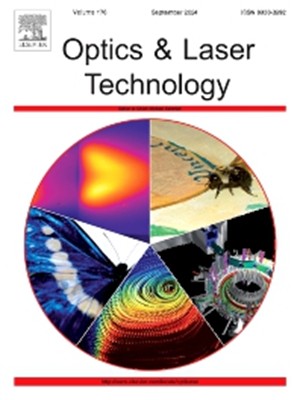Study on hybrid blue-IR laser welding on AZ31B magnesium alloy
IF 4.6
2区 物理与天体物理
Q1 OPTICS
引用次数: 0
Abstract
How to perform a laser welding is crucial to assure the quality of welds on magnesium alloys, and the challenges are the suppression of bubble generation and the reduction of pore defects. In this paper, hybrid blue-IR laser welding (HBI-LW) is proposed to improve the stability of a molten pool and keyhole; HBI-LW is produced by using dual coaxial lasers that have different wavelengths and spot diameters. A multi-physics heat flow model is developed to analyze the effect of composite heat sources on porosity quantitatively. The combined volumetric heat source model has been verified experimentally. The experiments show that when the laser power is 1800 W and the power of HBI is increased to 600 W, the porosity is formed at a lower level of about 0.5 %. The results are aligned well with that from numerical simulations on the proposed volumetric heat source model. In comparison with LW, HBI-LW is able to generate a larger melt pool and plasma plume and to smoothen the rear wall of a keyhole. This regulates the flow of the molten pool, suppresses the keyhole closure, and reduces the occurrence of keyhole collapse effectively. The dynamics of the keyhole and the forming mechanism of pores are investigated. This research provides theoretical and practical guides to suppress pore defects in laser welding on magnesium alloy.
求助全文
约1分钟内获得全文
求助全文
来源期刊
CiteScore
8.50
自引率
10.00%
发文量
1060
审稿时长
3.4 months
期刊介绍:
Optics & Laser Technology aims to provide a vehicle for the publication of a broad range of high quality research and review papers in those fields of scientific and engineering research appertaining to the development and application of the technology of optics and lasers. Papers describing original work in these areas are submitted to rigorous refereeing prior to acceptance for publication.
The scope of Optics & Laser Technology encompasses, but is not restricted to, the following areas:
•development in all types of lasers
•developments in optoelectronic devices and photonics
•developments in new photonics and optical concepts
•developments in conventional optics, optical instruments and components
•techniques of optical metrology, including interferometry and optical fibre sensors
•LIDAR and other non-contact optical measurement techniques, including optical methods in heat and fluid flow
•applications of lasers to materials processing, optical NDT display (including holography) and optical communication
•research and development in the field of laser safety including studies of hazards resulting from the applications of lasers (laser safety, hazards of laser fume)
•developments in optical computing and optical information processing
•developments in new optical materials
•developments in new optical characterization methods and techniques
•developments in quantum optics
•developments in light assisted micro and nanofabrication methods and techniques
•developments in nanophotonics and biophotonics
•developments in imaging processing and systems

 求助内容:
求助内容: 应助结果提醒方式:
应助结果提醒方式:


